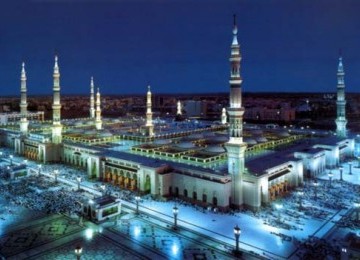City of Medina, commonly called Madinah Al-Munawwarah, is the main city in Saudi Arabia. Medina is a bustling city diziarahi or visited by the Muslims from all over the world. There is where the Prophet's Mosque, one of the three main mosques in addition to the Grand Mosque in Makkah and Masjid Aqsa in Jerusalem, Palestine.
The Prophet once said, "Madinah is haram (holy land) from this to this, should not be cut (cut) tree, and should not be carried out heresy in it. Whoever makes heresy (or protect those who do heretics) on it, then he hit curse of Allah, angels, and all mankind. "
The town is located about 600 miles north of Makkah Municipality has a population of about 600,000 inhabitants. For Muslims this city is considered as the second holy city after Mecca. At the time of the Prophet Muhammad SAW, this town became the center of preaching, teaching and the Islamic government. This is where the message of Islam spread throughout the Arabian peninsula and throughout the world.
Early in the development of Islamic preaching, this area known as Yathrib, a center of economy and trade in the region. When the Prophet migrated from Mecca this city, he later changed his name to Medina. Gradually the city became the center of propaganda and the Islamic government until the Prophet died and was buried there.
Prophet's Mosque is the second mosque built by the Prophet after the Quba Mosque, founded in the course of his hijrah from Mecca to Medina. Prophet's Mosque is the first mosque built the Prophet when he arrived in Yathrib (Madinah).
Its location is the place where he stopped the camel ride. This place is a place for drying dates originally owned by two orphan brothers Sahl and Suhail bin Amr. Rasulullah then buy it and then build a mosque and his residence.
Originally the mosque was built is very simple, with a clay material, piled palm trees and thatched palm midrib. Foundation only in the form of stacked clay mold stack. The Prophet himself who led the construction of a mosque measuring approximately 50 mx 50 m is approximately in 622 AD.
The layout of the mosque building was deliberately made governance a bit like building a house of the Prophet in Makkah. Part of the roof of the mosque was left open just like that. During the first nine years, this mosque without lighting at night. Only at the time of Isha, held a little illumination by burning straw.
After that, on one side of the mosque, built the residence of the Prophet. The residence of the Prophet is not how much and nothing more luxurious than the state mosque, of course, only more closed. In addition, there are also parts of the mosque which is used as a place of poor people who do not own a house, known as the Ahl Suffah or the occupants of the terrace of the mosque.
After that many times the mosque was renovated and expanded. Renovation of the first undertaken by the Caliph Umar ibn al-Khattab in the year 17 H, and the second by the caliph Uthman ibn Affan in the year 29 AH Later in the ruling Umayyad dynasty, Caliph al-Walid ordered the architects and engineers Arab expansion and the physical restoration of building the Mosque of the Prophet, another term of Masjid Nabawi.
Although these large-scale development, but the Caliph still wants the original structure of the mosque is not changed. In addition, the executing engineers also built the tower that serves as a muezzin call to prayer chanted. Minaret, at the time, considered a new element in the architecture of the mosque.
In the reign of Sultan Abdul-Majid I-Ottoman Dynasty-Nabawi Mosque renovation again occur. This time on a large scale. The Emperor ordered that all buildings demolished mosque, except the Prophet's room. Further expansion of the mosque to be rebuilt with up to 1293 meters. This is the last expansion before the Prophet's Mosque is handled by the government of Saudi Arabia.
At the time of King Fahd, the Prophet's Mosque again expanded in 1414 H, so that the building area of almost 100,000 square meters. Coupled with the construction of floors above the vast reaches 67,000 square meters and the court which can be used for prayer area of 135,000 sq. m. The entire complex of Nabawi Mosque can now accommodate approximately 700,000 pilgrims.
Prophet's Mosque has a number of virtues, such as the Prophet stated, "One prayer in this masjidku, greater reward than a thousand times prayers in other mosques, except in the Grand Mosque. And one more time praying in the Grand Mosque more than one hundred major thousand times prayers in other mosques. " (Reported by Ahmad)
"No need to put up the vehicle, except for visiting three mosques: Masjid al-Haram, this masjidku (Masjid Nabawi), and the Aqsa Mosque." (Bukhari, Muslim and Abu Dawud)
That's why the City of Medina and especially the Prophet's Mosque is the Muslims are always crowded with visitors from all over the world when the pilgrimage or Umrah.
In the Prophet's Mosque have a place called Raudhah (Parks), a place where all the prayers and diijabah granted by Allah SWT. No wonder the Hajj or Umrah pilgrims would spend the time to pray in this glorious place.
Source:www.republika.co.id/berita

No comments:
Post a Comment